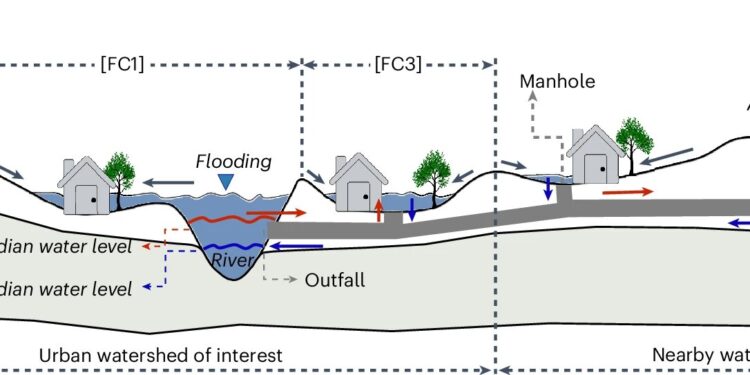Illustration of the main concepts related to urban flooding. Credit: Cities-Nature (2024). DOI: 10.1038/s44284-024-00116-7
Much of the nation’s stormwater management infrastructure, designed decades or even a century ago to prevent flooding, may be making flooding worse during severe weather events that are increasing worldwide, a new study from the University of Michigan shows.
The problem is that traditional urban planners fail to recognize flood connectivity: how surface runoff from driveways, lawns, and streets, as well as flows in river channels and drains, are all interconnected. The result is often unforeseen interactions between different stormwater management systems that can worsen flooding.
“When we design, we usually focus on localized solutions,” said Valeriy Ivanov, a professor of civil and environmental engineering at UM and co-first author of the study published in Cities-Nature“We have an area of concern, sometimes it’s a single parcel of land, or a collection of parcels that need to be connected by stormwater management infrastructure, and we design specifically for those areas.
“But these areas are affected by the flooding that occurs around them, which means that stormwater management infrastructure designed for this purpose can have unintended consequences.”
The study is based on the record-breaking rainfall that hit metropolitan Detroit on August 11, 2014, causing flooding across the region. The disaster closed highways, stranded motorists, and caused power outages and property damage to more than 100,000 homes, at a cost of $1.8 billion. The researchers analyzed data from that event, particularly from the city of Warren, and placed their findings in the context of stormwater design standards and flood warning practices in the United States to develop policy recommendations.
These include:
- Stormwater management system designs should take a holistic, systemic approach to flood mitigation, rather than the conventional approach focused on local solutions.
- Design guidelines for stormwater management systems should be revised to consider connectivity in urban landscapes, including flows in underground infrastructure such as pipes and sewers, flows in open channels such as rivers and streams, and overland flows on natural and built surfaces.
- Advanced computer models representing all elements of stormwater and the behaviour of the water they contain should be made mandatory.
- Design scenarios should represent the diverse spectrum of factors that control water flow in urban areas, such as complex rainfall regimes, antecedent soil water conditions, and the operation of existing stormwater drainage systems.
- Flood risk mapping approaches should expand their focus beyond floodplains adjacent to rivers to include risks in urban areas that may be remote from permanent water bodies.
“Current flood mapping practices are a sign of outdated thinking that needs to change,” said Vinh Tran, a U-M assistant research scientist in civil and environmental engineering and co-first author. “Whether it’s the Federal Emergency Management Agency or someone else who produces them, they only provide estimates for floodplains near rivers. But here’s the problem: In cities, flooding can occur far from any rivers or streams.”
“Take Warren, Michigan, for example. Official flood maps don’t show flood risk in parts of the city that are miles away from any major waterway. And that’s not just in Warren; it’s across the country.”
According to FEMA, flooding is “the most common and costly disaster in the United States.” That risk is increasing due to climate change.
Financially, this is a problem. FEMA notes that between 1980 and 2000, FEMA’s National Flood Insurance Program paid out $9.4 billion in insurance claims. Over the next 20 years, the program paid out $62.2 billion, an increase of more than 660 percent.
“Without updated design, the economic impact of flooding will only grow, placing a greater burden on governments and taxpayers,” said Jeff Bednar, Macomb County Environmental Resources Manager and a research contributor to the project. “By investing in resilient infrastructure now, we are not only protecting our environment, but also strengthening the foundation for economic growth.”
More information:
Vinh Ngoc Tran et al., Connectivity in urban landscapes can lead to unanticipated impacts on flooding from stormwater systems, Cities-Nature (2024). DOI: 10.1038/s44284-024-00116-7
Provided by the University of Michigan
Quote:Traditional infrastructure design often worsens extreme flooding, researchers say (2024, September 4) retrieved September 4, 2024 from
This document is subject to copyright. Apart from any fair dealing for the purpose of private study or research, no part may be reproduced without written permission. The content is provided for informational purposes only.



